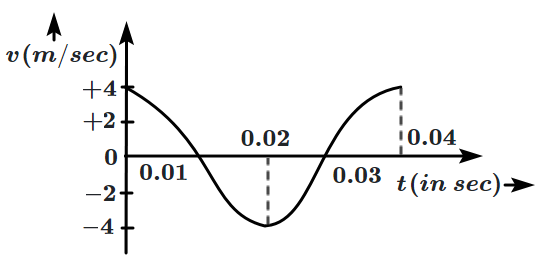The angular velocities of three bodies in simple harmonic motion are \(\omega_1, \omega_2, \omega_3\) with their respective amplitudes as \(A_1, A_2, A_3.\) If all the three bodies have the same mass and maximum velocity, then:
| 1. | \(A_1 \omega_1=A_2 \omega_2=A_3 \omega_3\) |
| 2. | \(A_1 \omega_1^2=A_2 \omega_2^2=A_3 \omega_3^2\) |
| 3. | \(A_1^2 \omega_1=A_2^2 \omega_2=A_3^2 \omega_3\) |
| 4. | \(A_1^2 \omega_1^2=A_2^2 \omega_2^2=A^2\) |
Subtopic: Simple Harmonic Motion |
91%
From NCERT
To view explanation, please take trial in the course.
NEET 2025 - Target Batch
Hints
To view explanation, please take trial in the course.
NEET 2025 - Target Batch
An SHM has an amplitude \(a\) and a time period \(T.\) The maximum velocity will be:
1. \({4a \over T}\)
2. \({2a \over T}\)
3. \({2 \pi \over T}\)
4. \({2a \pi \over T}\)
1. \({4a \over T}\)
2. \({2a \over T}\)
3. \({2 \pi \over T}\)
4. \({2a \pi \over T}\)
Subtopic: Simple Harmonic Motion |
90%
From NCERT
To view explanation, please take trial in the course.
NEET 2025 - Target Batch
Hints
To view explanation, please take trial in the course.
NEET 2025 - Target Batch
The equation of motion of a particle is \({d^2y \over dt^2}+Ky=0 \) where \(K\) is a positive constant. The time period of the motion is given by:
| 1. | \(2 \pi \over K\) | 2. | \(2 \pi K\) |
| 3. | \(2 \pi \over \sqrt{K}\) | 4. | \(2 \pi \sqrt{K}\) |
Subtopic: Simple Harmonic Motion |
76%
From NCERT
To view explanation, please take trial in the course.
NEET 2025 - Target Batch
Hints
To view explanation, please take trial in the course.
NEET 2025 - Target Batch
Displacement versus time curve for a particle executing SHM is shown in the figure. Choose the correct statement/s.

| 1. | Phase of the oscillator is the same at \(t = 0~\text{s}~\text{and}~t = 2~\text{s}\). |
| 2. | Phase of the oscillator is the same at \(t = 2~\text{s}~\text{and}~t = 6~\text{s}\). |
| 3. | Phase of the oscillator is the same at \(t = 1~\text{s}~\text{and}~t = 7~\text{s}\). |
| 4. | Phase of the oscillator is the same at \(t = 1~\text{s}~\text{and}~t = 5~\text{s}\). |

| 1. | \(1,2~\text{and}~4\) | 2. | \(1~\text{and}~3\) |
| 3. | \(2~\text{and}~4\) | 4. | \(3~\text{and}~4\) |
Subtopic: Simple Harmonic Motion |
72%
From NCERT
To view explanation, please take trial in the course.
NEET 2025 - Target Batch
Hints
To view explanation, please take trial in the course.
NEET 2025 - Target Batch
The velocity-time diagram of a harmonic oscillator is shown in the figure given below. The frequency of oscillation will be:


1. \(25~\text{Hz}\)
2. \(50~\text{Hz}\)
3. \(12.25~\text{Hz}\)
4. \(33.3~\text{Hz}\)
Subtopic: Simple Harmonic Motion |
73%
From NCERT
To view explanation, please take trial in the course.
NEET 2025 - Target Batch
Hints
To view explanation, please take trial in the course.
NEET 2025 - Target Batch
If the time of mean position from amplitude (extreme) position is \(6\) seconds, then the frequency of SHM will be:
| 1. | \(0.01~\text{Hz}\) | 2. | \(0.02~\text{Hz}\) |
| 3. | \(0.03~\text{Hz}\) | 4. | \(0.04~\text{Hz}\) |
Subtopic: Simple Harmonic Motion |
68%
From NCERT
AIPMT - 1998
To view explanation, please take trial in the course.
NEET 2025 - Target Batch
Hints
To view explanation, please take trial in the course.
NEET 2025 - Target Batch
The figure shows the circular motion of a particle. The radius of the circle, the period, the sense of revolution, and the initial position are indicated in the figure. The simple harmonic motion of the \(\mathrm{x\text-}\)projection of the radius vector of the rotating particle \(P\) will be:
1. \(x \left( t \right) = B\) \(\text{sin} \left(\dfrac{2 πt}{30}\right)\)
2. \(x \left( t \right) = B\) \(\text{cos} \left(\dfrac{πt}{15}\right)\)
3. \(x \left( t \right) = B\) \(\text{sin} \left(\dfrac{πt}{15} + \dfrac{\pi}{2}\right)\)
4. \(x \left( t \right) = B\) \(\text{cos} \left(\dfrac{πt}{15} + \dfrac{\pi}{2}\right)\)
Subtopic: Simple Harmonic Motion | Phasor Diagram |
51%
From NCERT
To view explanation, please take trial in the course.
NEET 2025 - Target Batch
Hints
To view explanation, please take trial in the course.
NEET 2025 - Target Batch



